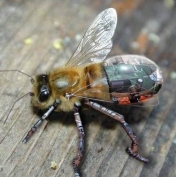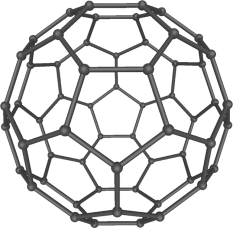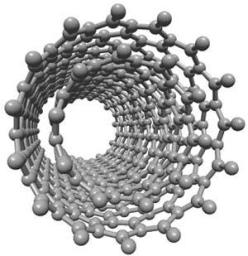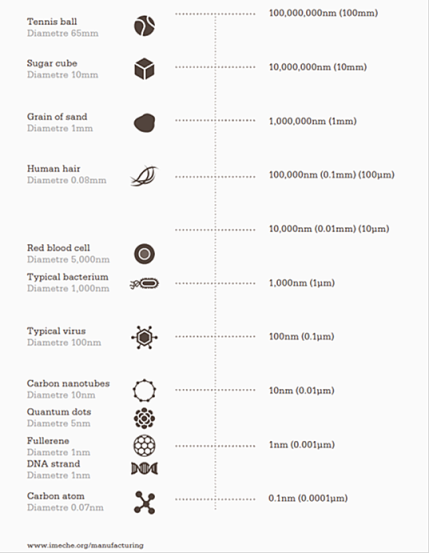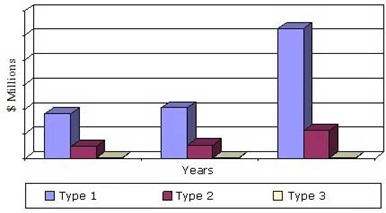“We cannot rely on trial-and-error approaches to deal with existential risks… We need to vastly increase our investment in developing specific defensive technologies… We are at the critical stage today for biotechnology, and we will reach the stage where we need to directly implement defensive technologies for nanotechnology during the late teen years of this century… A self-replicating pathogen, whether biological or nanotechnology based, could destroy our civilization in a matter of days or weeks.”
― Ray Kurzweil, The Singularity is Near: When Humans Transcend Biology
 The military is the largest investor in the U.S. Nanotechnology Initiative (NNI). The share of the NNI budget given to the Department of Defence (DoD) since the program started has reached $6.6 billion with part of the expenditure going to DARPA and the departmental laboratories of the Navy, Army and Air force, the rest ending up at universities as research grants or as part of the Multi-University Research Initiative (MURI).[1] Though spending has been fluctuating since 2007, there remains steady interest in nanotech’s military capabilities. Scientists for Global Responsibility (SGR) revealed from their research that: “… government funding for military R&D dwarfs that spent on social and environmental programs across the industrialized world …” with military R&D fixed towards “… a narrow weapons-based security agenda.” [2] Which means the marginalisation of conflict prevention and analysis of the roots of conflict and its links to poverty, the environment, security and health issues continue to be under-funded. Nanotech advances are being hijacked away from improving civilian life with “game-changing” technology as the culprit.
The military is the largest investor in the U.S. Nanotechnology Initiative (NNI). The share of the NNI budget given to the Department of Defence (DoD) since the program started has reached $6.6 billion with part of the expenditure going to DARPA and the departmental laboratories of the Navy, Army and Air force, the rest ending up at universities as research grants or as part of the Multi-University Research Initiative (MURI).[1] Though spending has been fluctuating since 2007, there remains steady interest in nanotech’s military capabilities. Scientists for Global Responsibility (SGR) revealed from their research that: “… government funding for military R&D dwarfs that spent on social and environmental programs across the industrialized world …” with military R&D fixed towards “… a narrow weapons-based security agenda.” [2] Which means the marginalisation of conflict prevention and analysis of the roots of conflict and its links to poverty, the environment, security and health issues continue to be under-funded. Nanotech advances are being hijacked away from improving civilian life with “game-changing” technology as the culprit.
A fervent need to make these grand visions a reality was given a sturdy platform for realisation back in 2007 from the DoD and their little known advisory body called the Defence Science Board (DSB) whose paper entitled: “DSB 2006 Summer Study on 21st Century Strategic Technology Vectors” laid some important groundwork for the future. In an attempt to place nanotech at the top of the military agenda the paper drew their attention to “synergistic combinations” of all forms of nanotech and their “… truly revolutionary capabilities in human performance enhancement, medical treatment and prophylaxis, miniaturization, life extension, robotics, and machine intelligence …” [3] It was unabashed in its agenda for clandestine tagging and tracking, where: “A combination of nanotechnology, biology, and chemistry promises to provide significant increases in capability to conduct pervasive surveillance on a global basis.”
Some of these other applications currently in R & D or primed and ready for action include the following:
Nano-biotechnology – or miniaturized biotechnology is the recent development of merging biology research with nanotechnology, most notably using biomolecules, bio-membranes and nano-photonics for vaccinations and virus research. Particularly active in medical fields the new science is seeking to generating cures; develop stem cell treatments, creating muscle tissue and artificial proteins. The convergence between computers and biology is of primary interest where eventually computing will be sourced from a biological platform where “Colonies of live neurons can live together on a biochip device.” [4]
Nano-electronics – The development of molecules with useful electronic properties which can then be used in nano-devices. This includes synthetic chemical methods and the creation of synthetic molecular motors. Other forms include carbon nano-tubes which have taken over from silicon-based chips. Now, the race is on to fit billions of these tubes onto computer chips thereby increasing the chip performance to “… run at more than three times the frequency and consuming just a third of the energy.” [5]
DNA nanotechnology – the construction of structures out of DNA and other nucleic acids. This branch has a special relationship to nano-medicine and “SMART drugs” for targeted drug delivery, the development and creation of vaccines and the adjacent field of nano-electronics with real world applications in both fields looming large. [6]
Nano-robotics/weaponry – self-sufficient machines operating at the nano-scale. Applying nano-robots in medicine are proving difficult due to a multitude of problems adapting to the biology of organic systems, though progress is there. However, military nano-robotics in combination with cybernetics is moving ahead in leaps and bounds. There are still very little scholarly articles on the nature and pace of advances on military robotics along with only a sluggish attempt at raising the ethical and moral issues inherent in the use of such weaponry. What is clear is that the military is getting very excited by it all due to the unlimited scope of applications. Reduced to the size of perhaps 0.1mm or less, autonomous mini and micro-robots could be deployed on the ground, in water and in air, using the same propulsion principles found in larger electronic and mechanical systems. All forms of movement are mimicked such as human legs, various types of hopping, flapping wings like a bird, flagella, and even side-winding movements of a snake. The multi-purpose nature of robotics means that weapons systems targeting, reconnaissance, communication and surveillance are easily utilized. Insects and small mammals are already being integrated into bio-cyborg hybrids with nervous system and brain interfacing with cybernetics, software and electrodes.
Returning to our whacky friends down at DARPA and their various sponsored companies and subsidiaries, we find they are still churning out helpful prototypes for new ways to spy, maim and murder. Some of these latest offerings are still prototypes, in the manufacturing stage or on the drawing board. They comprise:
1) Nano-Scouts – real insects and simulated bird-like technologies which act as the eyes and ears of intelligence. Flies and mosquitoes have embedded nanotech capabilities which allow them to determine the presence of certain chemicals, changes in moisture levels or barometric pressure, and be able to sense movements, temperature, and vibration.[7]
2) Nano-Poisons – A variety of toxic substances with nanomolecules carefully tailored to illicit the correct responses. By interfering with neuro-chemical inhibitors and release agents introducing precise “onboard” quantities of synthetic poisons behaviour modification is taken to a whole new level. Almost any type of mind control would be available from encouraging the victim to lie obsessively to provoking suicidal thoughts; stimulating a person to react violently or to kill. And of course, a Brave New World of somatic release could be programmed where the person cannot help but love everyone and where anger and aggression is blocked. Nano-molecules would effectively quadruple the effectiveness of purely psychological methods of mind control.
3) Nano Force Fields –nano-coatings which can hermetically seal a vehicle or building by allowing particles to seek out air gaps and block them.
4) Nano Mind Erasers – Want to take out a politician or spy without fuss or bother of assassination? Then, inducing the equivalent of instant Alzheimer’s is the answer. Wiping the sections of the brain clean using micro fields programmed to flare up as tiny, molecular neutron bombs would do the trick.
5) Nano Needles – With no visible wounds and invisible to the naked eye these weapons represent an up-dated version of the old KGB poison-tipped umbrella. The needles could be shot from a suitably modelled gun to paralyse people. Presumably the lethal nature of the needles would be dependent on their carrier capability.
6) Nano Heart-Stoppers – Nano-blood flow restrictors and Stroke Inducers – Long known to be a part of military-intelligence operations the assassination of sensitive targets such as politicians, heads of state and celebrities. Undetectable in the blood stream, nano-molecules could mimic heart attacks or strokes; restrict the blood flow causing an array of symptoms, even inducing personality disorders.
7) Nano-Naut Swarms – These are ‘SMART dust’ particles which act as an information or sensor clouds capable of analysing areas with sharp detail and relying back information to HQ. As reported in the MSM in early February 2013, the British Army has been deploying tiny nano-drones in Afghanistan for over two years. At just 10cm long and weighing only 16 Grams they are used to relay full motion video and still images back to the devices’ handlers. But technology is advancing as fast as weapons can be bought.
8) Cyborg Insects – could be the delivery tool of much of the above allowing viruses and lethal substances to be to their individual or mass target, something that Bill Gates and his forays into mosquito-driven vaccines would no doubt happily welcome. Spying and surveillance capabilities have also been successfully tested and deployed. One of DARPA’s less malevolent offerings, the Nano Hummingbird was named One of Time Magazine’s 50 best inventions of 2011. Shaped like a humming-bird the mini robot is remotely-controlled without an external power source and can fly, hover, move forward and backward in the air while shooting Hi-Resolution video.
9) Programmable Matter – Starting in 2007, with DARPA support, Carnegie Mellon delved into the possibility of creating hardware and software to make material that can programmed to morph into 3-Dimensional shapes – essentially, shape-shifting. Named the Claytronics Project, the brains behind this venture believe that it has the capacity to change every facet of human experience. They consider claytronics to be a platform for a new form of called “Pario” with the reproduction of moving 3-D objects the primary goal. In other words, the quest to program the world around us. Just a few years later in 2010 with a “self-folding origami” robot which can literally fold itself up and crawl away. Meantime, shape-shifting sand made an appearance in 2012 where; “New algorithms enable heaps of ‘smart sand’ that can assume any shape, allowing spontaneous formation of new tools or duplication of broken mechanical parts.” This of course begins to the blur the whole fields of nanotechnology bioengineering, cybernetics, biological-based pharmaceuticals, programmable vaccines and the advance of synthetic biology.
The US Department of Defence is also researching the feasibility and applications of robotic mosquitoes. So far testing has found that they can be remotely controlled with an on-board camera and a microphone. They will be able to land on unsuspecting dissidents or terrorists with the potential to take a DNA sample or leave RFID tracking nanotechnology on your skin. Flying in through a crack in your window or attaching itself to your clothing in passing would prove no problem for these adorables. No doubt law enforcement and Homeland Security are salivating at such a prospect. [8] In fact, sightings of insect-like drones have been occurring for years in the US, most frequently at activist demonstrations and marches. According to a 2006 Flight International report: “… the CIA had been developing micro UAVs as far back as the 1970s and had a mock-up in its Langley headquarters since 2003.”
 Assuming such machines can fly onto a local protester’s arm and then wing its way back to its controller with a fresh little DNA sample to analyse, this compliments another disturbing scenario as described by authors Andrew Hessel, Marc Goodman, and Steven Kotler who “…outline futuristic human genome work that evolves from the very real GE $100 million breast cancer challenge.” In this scenario: “freelancers receive bids to design personalized virus offering customized cures for the sick.” An individual succumbs to colon cancer and instead of going the route of standard chemotherapy he chooses an immediate payment of $1000 to have his genome decoded over two days. Virologists of the near future will have information about the disease and the exclusive genome sequence. The design cure will be outsourced the winning bid providing the formula to rid your body of the specific cancer. Targeting the US President by criminal cartels or terrorist cells would be relatively easy.
Assuming such machines can fly onto a local protester’s arm and then wing its way back to its controller with a fresh little DNA sample to analyse, this compliments another disturbing scenario as described by authors Andrew Hessel, Marc Goodman, and Steven Kotler who “…outline futuristic human genome work that evolves from the very real GE $100 million breast cancer challenge.” In this scenario: “freelancers receive bids to design personalized virus offering customized cures for the sick.” An individual succumbs to colon cancer and instead of going the route of standard chemotherapy he chooses an immediate payment of $1000 to have his genome decoded over two days. Virologists of the near future will have information about the disease and the exclusive genome sequence. The design cure will be outsourced the winning bid providing the formula to rid your body of the specific cancer. Targeting the US President by criminal cartels or terrorist cells would be relatively easy.
A 2010 release of secret cables by WikiLeaks, Secretary of State Hillary Clinton ordered US embassies “… to surreptitiously collect DNA samples from foreign heads of state and senior United Nations officials.” [9]With that in mind, an article by Atlantic magazine takes the next logical step in personalised bio-weapons and micro-drones.
Picture an African President busy with civil war and child soldiers. Perhaps his DNA had been sampled as part of a UN / US mandate. A drug is tailored to that genome sent to an online bio-marketplace and synthesised into actual genetic material. The authors explain that it is here that “… the future of drones and virology could intersect.”
The article continues:
A few days later tablets are delivered to a group that dissolves them and injects the liquid into a handful of micro-drones. The team releases the drones and infects the people in the African leader’s circle of advisors or family. The infected come down with flu like symptoms, coughs and sneezes that release billions of harmless virus particles — but when they bring their symptoms in the vicinity of the African leader — the particles change. Once the virus particles are exposed to that very specific DNA sequence, a secondary function within their design unlocks.[10]
Perhaps the formula contained a “fast-acting neuro-destructive disease that produced memory loss and, eventually, death.” For the African leader or any other head of state which was proving an obstacle to US hegemony “the symptoms could be tailored an infinite number of ways. Designed to reflect a uniquely local affliction like Dengue Fever, or to appear like symptoms of a genetic condition.” [11]Combined with the inherent nature of the military-coporate-banking complex and with their puppet Obama who sees no problem with murdering American citizens via remote drone attacks discarding any notions of law and democratic due process, then you can be sure that such a scenario will take place in the very near future – if it hasn’t already.
The above scenario set against military nanotechnology and other forms of “non-lethal” warfare is justified due to the threat of terrorism and the belief that we can all bring an end to the world’s violence and crime. It is believed that technology will save the day on the battlefield and in civilian life. If left to these people it would rapidly start to resemble an endless battle in itself, which is the general idea. Convincing people not to act on their “evil” thoughts by allowing nano-dust particles to seep into their brains is bread and butter behaviour modification. For anyone else, it is a step towards a Huxleyian nightmare.
Although many commentators prefer to believe that the fail-safe mechanisms of quantum computing and the intelligence apparatus would be enough to protect mainstream society, they fall into the trap of believing that those of conscience are presently guiding humanity. Once again, you cannot use a juvenile dictionary to explain a psychopathic reality that is operating on an entirely different cognitive and perceptual mainframe.
The fractal nature of the nano-world of military applications means that advances in weaponry would take place exponentially with a modus operandi that would excite any social dominator beyond all measure. Using the premise of the molecular assembler, a device capable of breaking and creating the chemical bonds between atoms and molecules, it means duplication is not only feasible and efficient but a requirement once the technology is up and running. Think of the white Storm-trooper clones in the Star Wars films – very much military-technocratic ambrosia. As nanotech guru Eric Drexler explained: “a state that makes the assembler breakthrough could rapidly create a decisive military force – if not literally overnight, then at least with unprecedented speed.” He further observes: “A nation armed with molecular nanotechnology-based weapons would not require nuclear weapons to annihilate a civilization. In fact, it seems that a rather surgical system of seeking and destroying enemy human beings as cancerous polyps could be developed–leaving the nation’s infrastructure intact to be repopulated.” [12]
A research paper sponsored by the European Commission for a 2004 conference on the military uses of nanotechnology and the hazards to society at large, came to some sobering conclusions. While the benefits in medical and non-military domains was clear and should not be unduly hindered provided regulations and ethical boards were swiftly introduced, there were a number of indirect ways that society could be: “detrimentally affected” through the “diffusion of the technology.” The paper offered some examples, including the temptation for the National Security State and related agencies, corporations and criminals to purloin micro-sensors and robots for spying, as well as: “the use of small autonomous systems for criminal attacks – and in particular terrorism – including attacks on critical infrastructures.” They also included a third possibility, that of:
“… implanted systems and other forms of body manipulation for ‘improving human performance’. Deciding what kinds of body manipulation should be permitted, and under which circumstances is a problem of peacetime civilian life, and should be handled by civilian society. However, military R&D and deployment of such systems could establish a fait accompli before society is able to carry out a thorough debate on the desirability of particular technological developments.”
And there’s the problem.
The last thing psychologically compromised persons enjoying their place at the helm of Official Culture is to see the involvement of local communities and civic society. Genetically modified organisms and foodstuffs went this way as did television, banking, media, warfare and most other socio-political power structures which required either secrecy, perception management or corporate monopolisation to ensure a singular reality. Nanotech will be no different if it is allowed to continue without regulations and in the hands of those who wield power for their own ends. If we have humans behaving in psychopathic ways then it doesn’t require the greatest leap of imagination to realise that military robots will be a reflection of their state of mind and intentions. Pathocratic control systems require global dominance in all domains and nanotech represents a mighty leverage in the race to achieve it. Horizontal proliferation would be nearly unavoidable with small, self-replicating systems where in principle, a single copy would be sufficient for growth in another country or sub-state entity.
The report goes on to state:
Military robots with sizes from nanometres to metres would bring threats on an unknown scale. If they could kill, they could constitute new forms of weapons of mass destruction more potent than known biological warfare agents. With non-lethal effects, such as disruption of personality, mass attacks could lead indirectly to the breakdown of a society and the death of a large portion of its members. Partly as a result of their smallness, but mainly owing to their potential for self-replication and the production of additional weapons on site, nano-robots would create extreme uncertainty. [13]
Given the nature of nanotech, automated decision making would grow based on its tendency for a kind of peak, fractal replication to emerge, once technological thresholds have been reached and surpassed. When this level of technology fuses with the mentality of unlimited growth much like the standard economic mind set currently dominating, then a virtual arms-race at the molecular level could ensue with entirely unforeseen consequences. Military production overlaid with ideological insanity.
“Buckminsterfullerene C60, also known as the buckyball, is a representative member of the carbon structures known as fullerenes. Members of the fullerene family are a major subject of research falling under the nanotechnology umbrella.” (uploaded by Mstroeck at English Wikipedia Later versions by Bryn C at en.wikipedia)
Alongside the massive drive to foist genetically modified foods on global populations agribusiness is fascinated by the part nanotech can play in making food production and consolidation more efficient. However, using molecular assembly principles “nano scale carriers” will soon be used for delivering fertilizers, pesticides, herbicides and plant growth regulators. A case is being made to reduce environmental impact with nanotech. It is believed that this will improve stability and lessen environmental degradation in terms of chemical runoff and other related problems. An example of these carriers would be the use of clay nanotubes for pesticides which will apparently reduce the amount of pesticide use by 70–80 per cent. Nanoparticles can act to help mollify and transform resistant chemical compounds in to non-toxic ones while waste water treatment and disinfectants have the potential to be markedly improved. Fluorescent labelling by “quantum dots” (QDs) using bio-recognition molecules for anti-bacteria and disease control will be supplemented with an array of rapid detection and enzymatic biosensors. There is even a device called the “E-Nose” inspired by the human nose which, through the use of nanoparticle gas sensors can detect precisely the quality and quantity of gas present. [14]
Socio-economic demands will ensure that wireless nanosensors in crops designed to monitor and collate data on agronomic intelligence processes such as planting and harvesting cycles will become more and more important. Water levels, fertilizers, pesticides, herbicides and other treatments will also be under the nanosensor umbrella in the hope that maximization of crop yields and a reduction in resource input will be the end result. [15]
Biotechnology at the nanoscale is already having some success in the battle against plant resistance and environmental stresses such as drought, salinity and diseases. Nanobarcodes will be used for authentication and tracking in agricultural food and husbandry products. As knowledge grows in the area of plant gene traits and nanotechnology-based gene sequencing it is taken for granted that such process will offer new ways to reduce costs and maximize profits. [16] With undoubted benefits that nanotechnology can provide, this is still inside the constraints of Official Culture. Farming has already been transformed into a leviathan of corporate efficiency where community, civic and independence has been sacrificed. Nano-farming may increase the overall efficiency and provide intermittent benefits, but will it have the capacity to transform agriculture away from agribusiness corporatism?
If new endeavours are dominated by the matrix of the 4Cs and the 3EM then it will limit the hope for social renewal and become just another tool to increase exploitation still bound by the same lowest common denominator. Consumerism, far from being modified or somehow reduced under this new technology will only intensify mechanisation, commodification and the encoding organic life, this time at the molecular level. Nanotechnology may have a place in improving humanity’s lot but not by being grafted onto a socio-political and economic framework that caused the problems in the first place.
Quite apart from providing new innovative tools for medical advances and the promise of an agricultural revolution, evidence so far in relation to health and environmental concerns doesn’t exactly promote confidence. Some of the latest research results show that:
- Rats breathing in nanoparticles were found to exhibit inflammation, skin aging and stress responses.
- DNA and chromosome damage which in turn “linked to all the big killers of man, namely cancer, heart disease, neurological disease and aging”.
- Carbon nanotubes – the possible replacement for silicon – have shown to have the potential to cause mesothelioma ( a form of cancer).
- Nanoparticles and nanofibres have shown to cause lung disease in a similar way to asbestos. [17]
Mark Wiesner Professor of Civil and Environmental Engineering at Duke University in Durham N.C., has argued for a rethink as to the way nanoparticles are selected and defined in relation to potential impacts on human health and the environment. His international team of researchers from the federally-funded Centre for the Environmental Implications of Nanotechnology (CEINT), based at Duke University in the United States, have raised a number of issues which need to be addressed if nanotechnology is to prove viable and ethically responsible. He believes there is presently confusion as to what truly constitutes a nanoparticle where “… materials often do not meet full definition of having special properties that make them different from conventional materials.” According to Wiesner, a key question that needs to be answered: “… is whether or not a particular nanoparticle has toxic or hazardous properties that are truly different from identical particles in their bulk form,” and this due to the fact that: “Many nanoparticles smaller than 30 nanometers undergo drastic changes in their crystalline structure that enhance how the atoms on their surface interact with the environment.”
The professor explains further:
“…because of the increased surface-area-to-volume ratio, nanoparticles can be highly reactive with other chemicals in the environment and can also disrupt certain activities within cells. … “While there have been reports of nanoparticle toxicity increasing as the size decreases, it is still uncertain whether this increase in reactivity is harmful to the environment or human safety,” Wiesner said. “To settle this issue, toxicological studies should contrast particles that exhibit novel size-dependant properties, particularly concerning their surface reactivity, and those particles that do not exhibit these properties.” [18]
Perhaps it is not the health and environmental issues which are really the problem. We humans are extraordinarily creative and ingenious. All the above is driven on the assumption of cybernetics and its systems theory as viable working models; the idea of “nested” organic systems and dissipative structures which are interrelated and interconnected by virtue of their functional similarity. *This means that bio-engineers and technocrats look at nanosystems as providing the potential for exponential growth via automatic and autonomous emergent properties. As described previously, this opens up a whole new pandora’s box when matter becomes programmable.
According to nano scientists this follows that society and the human condition is about to “reshaped” in very positive ways: cleaning the environment, easing the pressure for natural resources, tackling hunger, curing AIDS and other invasive diseases; giving new life to paraplegics whilst enhancing the human body. However, will these laudable aims be set against a background of unresolved questions which threaten to undermine the human species? What has happened to new advances in technology in the past?
Nanotech advocates display frightening naïveté in this regard and an often ironic binary evaluation of what are highly complex issues, notwithstanding an ignorance of ponerology and psychologically compromised cultures. It is a contradiction to say that strengthening our democratic processes will somehow ensure responsible ethics which will insulate against the darker applications of nanotechnology when overwhelming expenditure is already focused in the hands of those who seek weapons advancement and shareholder profits. A barrier to accountability will remain as tenacious as it has proved to be in narcotics, conventional weapons and trafficking. It benefits the Establishment just as nanotechnology promises to do.
Futurist David Brin’s prescription to cultivate a “transparent society” where privacy is effectively non-existent is dangerous as it opens the backdoor for just about every totalitarian precept going. The self-replicating nature of molecular nanotech has given rise to end time scenarios where machines take over the world replacing humanity and organic life. Eric Drexler coined the term “grey-goo” otherwise known as ‘ecophagy’ to illustrate such a cybernetic apocalypse.[19]Think along the lines of “the Collective” from the Borg in the Star Trek TV series or the “Hive mind” so beloved of humanists and transhumanists. Expansion derives from assimilation and adaptive properties – “group think” in a futurist setting.
Corporations will be regulated insofar as it does not impinge on the market value of nanotechnology. This means regulations in medical and consumer arenas where it matters less will be followed. Where it is most needed however, is in domains such as weaponisation and agriculture and which will likely follow the traditional route of lobbyists and cartel economics – the path of least resistance. Meanwhile, legislation will have a very tough time keeping up with the rise of nanotechnology especially when environmental and privacy laws are only applicable to those adhering to the public domain and wholly irrelevant to government /corporate experimentation outside such accountability.
Although the military is driving nanotech advances (as with all things) the testing ground has begun with many “passive” or “first generation” commercial applications finding their way to the market place. As explored in the previous post the list is endless. If sunscreen products in the US contain nanoparticles and thus freely pass through the blood-brain barrier then the background of complex toxicology issues must remain at the forefront. In the same way, as GMOs, Wi-Fi and cell phones all have serious health questions hanging over them and health and environmental concerns of nanomaterials at this early stage have been completely ignored. Issues of privacy and confidentiality are also profoundly important.
The precautionary principle means that it is essential not to jump in feet first with this technology when there is an absence of suitable definitions regarding nanoparticle properties which could help scientists determine what represents a threat to the environment or human health. Despite certain advocacy groups calling for government regulation, the only principle which governs decisions is the one leading to the quickest possible profit. Nanotech forges ahead, in love with itself and its seemingly unlimited potential.
It doesn’t take a genius to see that it will go the same way as GMOs since the focus behind the drive to conquer nature, deny death and embrace immortality is exactly the same. Until regulation, insurance and extensive public discussion is forthcoming it is likely the more negative scenarios surrounding nanotech will play a greater role. After all, once the perceived genie is out of the bottle the consequences of its “magic” are more difficult to manage. This means that with all the wondrous potential for cleanng up the environment patents will arrive forcing us to pay for such ecological magic just as it was with the so-called “Green Revolution” of genetically modified crops. This means an expansion of selective wealth where transformation happens according to your pocket and status thereby replicating the same old divisions and class divides.
To reiterate the immovable direction of technology: it is the military and nano-weaponry which will determine the future of nanotech as a whole not whether a surgeon can provide life-saving operations or the disabled individual can begin to walk again. Altruism is not the primary currency of social exchange in a world shaped by psychopaths. Nanosystems will be nurtured on the same directive until such time we can wrest control.
* Dissipative Structure – A system that exits far from thermodynamic equilibrium thus dissipating the heat generated to sustain it. It has the capacity of changing to higher levels of orderliness leading to self-organization. These systems contain sub-systems that continuously fluctuate.
Notes
[1] ‘More soldiers in nanotechnology labs?’ By Michael Berger, nanowerk.com August 22, 2007.
[2] Ibid.
[3] http://www.acq.osd.mil/dsb/reports/2006-02-Summer_Study_Strategic_Tech_Vectors_Vol_I_Web.pdf
[4] NanoMedicine – A Review by K.K. Senthil Kumar, International Journal of Innovative Drug Discovery, Vol. 2 / Issue 1 / 2012 / 40-47 (from International Journal of Biopharmaceutics)
[5] ‘Carbon nanotubes fit by the thousands onto a chip’ By Jason Palmer, BBC News, 29 October 2012.
[6] DNA nanotechnology and transhumanism seem to fit snugly together in terms of their technological vision for humanity. Whether or not most persons working in the field are predisposed to this belief is irrelevant but the belief that vaccinations across the board are absolutely necessary and beyond reproach is a powerful part of the medical establishment. As such, the transhumanist paradigm naturally joins forces with materialism, atheism and corporatism to unfold their agenda accordingly. Journalist Sayer Ji has this to say on the subject:
“Not only have humans strayed from their mammalian roots by creating and promoting infant formula over breast milk, and then promoting synthetic immunity via vaccines over the natural immunity conferred through breastfeeding and sunlight exposure, for instance, but implicit within the dominant medical model is to replace natural immunity with a synthetic one. This is the philosophy of transhumanism, a movement which intends to improve upon and transcend our humanity, and has close affiliation with some aspects of eugenics.
The CDC’s immunization schedule reflects a callous lack of regard for the 3 billion years of evolution that brought us to our present, intact form, without elaborate technologies like vaccination — and likely only because we never had them at our disposal to inflict potentially catastrophic harm to ourselves. The CDC is largely responsible for generating the mass public perception that there is greater harm in not “prophylactically” injecting well over 100 distinct disease-promoting and immune-disruptive substances into the bodies of healthy children. They have been successful in instilling the concept into the masses that Nature failed in her design, and that medical and genetic technologies and interventions can be used to create a superior human being.
In this culture of vaccination, the non-vaccinated child is “inferior,” “dirty,” perhaps even “sub-human” to those who look upon vaccination as the answer to what perfects the human immune system.
Transhumanism participates in a dialectic which requires a simultaneous and systematic dehumanization of those who do not share the same way of thinking and behaving. The eugenic undertones of mass vaccination and the cult of synthetic immunity are now only thinly veiled, as we move closer to the point where a psuedo-scientific medical dictatorship lays claim to our very bodies, and the bodies of our children.
The point of no return (if not already traversed) is only around the corner: the mass introduction of DNA and Recombinant Vector Vaccine technology. Vaccines moved through the following stages (a tortured history of failures and massive “collateral damage”): Live Vaccines > Attenuated Vaccines > Subunit Vaccines > Toxid Vaccines > Conjugate Vaccines, only now reaching towards converting our living tissue into “vaccine-making factories” through the use of DNA and Recombinant Vector Vaccines, which are designed to directly alter cells within the vaccinated person’s body so that they create the antigens normally provided by vaccines themselves.
While not yet in use, clinical trials are now underway to obtain FDA approval. If we do not educate ourselves now and act accordingly, their mass implementation is inevitable, and our very genomes will become the next target of the vaccination/transhumanist agenda.” – ‘The Vaccination Agenda: Implicit Transhumanism’ By Sayer Ji, Contributing editor, Activist Post, January 24, 2012.
[7] Most Innovative Defense Technology’ 2008 Award Nominee – Nano SCOUT AeroVironment Inc.| http://www.defense-update.com/ | ‘The dragonfly built to spy – Tiny flying robots have the military abuzz, says Mark Harris’ http://www.timesonline.co.uk/tech.
[8] A COMBINED EXPERIMENTAL-NUMERICAL STUDY OF THE ROLE OF WING FLEXIBILITY IN INSECT FLIGHT Lingxiao Zheng, Xiaolin Wang, Afzal Khan, R. R. Vallance and Rajat Mittal1 Department of Mechanical & Aerospace Engineering, George Washington University, Washington DC 20052 Tyson L. Hedrick 2009. http://www.me.jhu.edu/fsag/Publications/Papers/AIAA-2009-382-170percent5B1percent5D.pdf
[9] ‘Hacking the President’s DNA’ November 12, The Atlantic Magazine, By Andrew Hessel, Marc Goodman and Steven Kotler.
[10] ‘Micro-Drones Combined With DNA Hacking Could Create A Very Scary Future’ By Robert Johnson, Oct. 28, 2012. Business Insider | http://www.businessinsider.com/
[11] Ibid.
[12] ‘A Glimpse Into China’s Post-Nuclear Super-Weapons: An Interview with Lev Navrozov on Nanoweapons by Ryan Mauro for http://www.worldthreats.com Sept. 26, 2003. | Quotes sourced from Engines of Creation By Eric Drexler (1986).
[13] ‘Military Uses of Nanotechnology – European Commission’ ec.europa.eu/research/conferences/2004/ntw/pdf/soa_en.pdf
[14] ‘How helpful is nanotechnology in agriculture?’ By Allah Ditta 2012 Adv. Nat. Sci: Nanosci. Nanotechnol. 3 033002 doi:10.1088/2043-6262/3/3/033002 Vietnam Academy of Science & Technology, 29 May 2012. IOP Science | http://iopscience.iop.org/2043-6262/3/3/033002/article#ansn431989bib05
[15] Ibid.
[16] ‘The potential and challenges of nanopore sequencing’ Nature Biotechnology 26, 1146 – 1153 (2008) Published online: 9 October 2008 | doi:10.1038/nbt.1495
[17] ‘Tiny Inhaled Particles Take Easy Route from Nose to Brain’ August 3, 2006, University of Rochester Medical Centre. | Wu, J; Liu, W; Xue, C; Zhou, S; Lan, F; Bi, L; Xu, H; Yang, X et al. (2009). ‘Toxicity and penetration of TiO2 nanoparticles in hairless mice and porcine skin after subchronic dermal exposure’. Toxicology letters 191 (1): 1–8. doi:10.1016/j.toxlet.2009.05.020. PMID 19501137. | Jonaitis, TS; Card, JW; Magnuson, B (2010). ‘Concerns regarding nano-sized titanium dioxide dermal penetration and toxicity study’. Toxicology letters 192 (2): 268–9. doi:10.1016/j.toxlet.2009.10.007. PMID 19836437. | Schneider, Andrew, ‘Amid Nanotech’s Dazzling Promise, Health Risks Grow’, March 24, 2010. | ‘ Nanofibres ‘may pose health risk’,’ BBC News, August 24, 2012. | ‘Is Chronic Inflammation the Key to Unlocking the Mysteries of Cancer?’ By Gary Stix, Scientific American, July 2007.
[18] ‘When Nano May Not Be Nano’ Duke University, Depart. Civil & Environmental Engineering September 14 2009.
[19] ‘Some Limits to Global Ecophagy by Biovorous Nanoreplicators, with Public Policy Recommendations’ By Robert A. Freitas Jr. April 2000. | www.rfreitas.com/Nano/Ecophagy.htm
